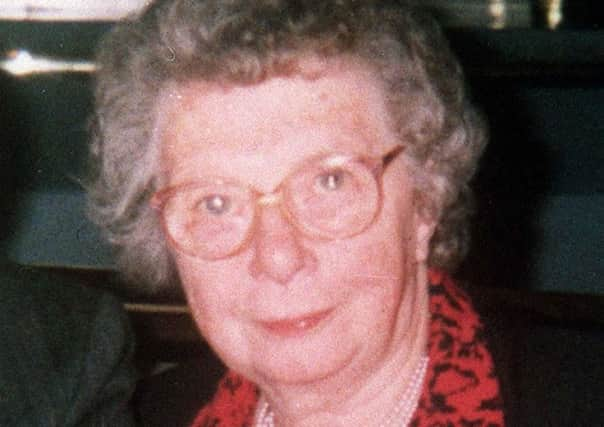‘Nine pointers to collusion’ in murder of Dungannon pensioner Roseann Mallon


A barrister for Roseann Mallon’s family said while there was no direct evidence of an army or police role in the 1994 Ulster Volunteer Force (UVF) killing, he insisted those involved in collusion always took steps to ensure no such linkages existed.
Outlining the nine issues of concern as he made final submissions in the long-running case, Barry McDonald QC said: “The combination of all the circumstances we have identified reinforces the family in its conclusion that the UVF didn’t act alone or unaided when they murdered Roseann Mallon.
Advertisement
Hide AdAdvertisement
Hide Ad“In their view there were state forces at work here in both the events leading up to the murder and the events that followed.”


In response, a lawyer for the Police Service of Northern Ireland and Ministry of Defence acknowledged there were “frailties and shortcomings” in the investigation of the murder but rejected the allegation of collusion.
Kevin Rooney QC told the court: “It would be totally wrong and manifestly unjust to translate these frailties and shortcomings into evidence of collusion.”
After hearing closing submissions from both barristers, the judge presiding over the inquest, Mr Justice Weir, said he would deliver a reserved verdict at a later date.
Advertisement
Hide AdAdvertisement
Hide AdMs Mallon was shot dead when the UVF shot through the living room window of her sister-in-law’s Co Tyrone home in May 1994.


The UVF said its notorious mid-Ulster brigade was responsible and was targeting two of Ms Mallon’s nephews, Christopher Mallon - who was not home at the time - and Martin Mallon, who lived half a mile away. Both were involved with the republican movement.
In the aftermath, military spying equipment was found in a field nearby the Mallon bungalow on Cullenrammer Road at the edge of Dungannon - a discovery that first sparked the claims of security force collusion.
The covert camera was relaying footage to an Army unit posted in a nearby wood.
Advertisement
Hide AdAdvertisement
Hide AdThe inquest has previously heard how tape recordings were wiped and the camera was unable to operate in poor weather and darkness.
No one has ever been convicted of Ms Mallon’s murder although high-profile killer Billy Wright, who was himself shot dead in 1997, and two other loyalists were arrested and questioned.
In December 2013, the inquest was dramatically halted after it emerged that the weapon used to murder Ms Mallon had been linked to a series of other loyalist killings in the east Tyrone area.
That countered the findings of the little-known police intelligence unit - the Weapons and Explosives Research Centre (Werc) - which examined the gun at the time and erroneously determined it had no past history in Northern Ireland.
Advertisement
Hide AdAdvertisement
Hide AdMr McDonald highlighted the failure to capture camera footage of the events around the murder, including a scouting mission in the days before, and the misidentification of the weapon among the issues the family believe point to collusion.
He also highlighted:
: failure by the police or army to intercept the getaway car at check points.
: failure to retain records of police transmissions on the night of the murder.
: witness sightings of unexplained army activity at an old mill close to the Mallon home the day before.
Advertisement
Hide AdAdvertisement
Hide Ad: a “wilful” failure by the Royal Ulster Constabulary’s Special Branch to tell the murder investigation team on the ground that there was a covert surveillance operation on-going.
: a “wilful” failure by Special Branch to share intelligence with the murder detectives.
: no record of finger print tests being carried out on bullet cartridges found at the scene.
: destruction of potentially relevant evidence, such as police note books belonging to the then head of RUC CID and the regional head of the Special Branch.
Advertisement
Hide AdAdvertisement
Hide AdMr McDonald said nothing had emerged that established a “direct” link to collusion.
But he added: “The absence of evidence of direct collusion should not lead to the conclusion that there was no collusion in this case.”
Mr Rooney countered the points made by Mr McDonald when he rose to outline his closing submission.
Among the points made, the lawyer stressed that the covert camera was not trained on the home, but on an engineering business on the opposite side of the road, and as such could not have recorded the crime.
Advertisement
Hide AdAdvertisement
Hide AdHe said there was no evidence that linked army activity in the area to the killing.
The lawyer stressed that in 1994 there was no policy of retaining police note books and it would not have been uncommon for officers to dispose of books once they had been filled-up.
The said intelligence on the killers was “sparse” and said while there was no record of fingerprint tests on the cartridges, full forensic examinations of the gun, magazine and a bullet in the breech were undertaken.
He added: “I submit that the police investigation was an extensive one. However there’s no investigation that is perfect and I accept sir that the inquest proceedings have identified some frailties and shortcoming in the investigation.”
Advertisement
Hide AdAdvertisement
Hide AdThe inquest heard that the evidence to the court could not be formally closed until an outstanding disclosure issue has been resolved on police papers that have only recently been located.
Noting that was just one of a series of disclosure problems throughout the 18 months the inquest has been open, Justice Weir characterised the police’s explanation as “Alice in Wonderland”.
He told Mr Rooney he wanted the outstanding issue dealt with before the end of the legal term.
Reserving his verdict, he said: “I would like to give some thought to this matter. I would like to get the evidence formally closed up before the end of term and I will deal with this as soon as I can.”